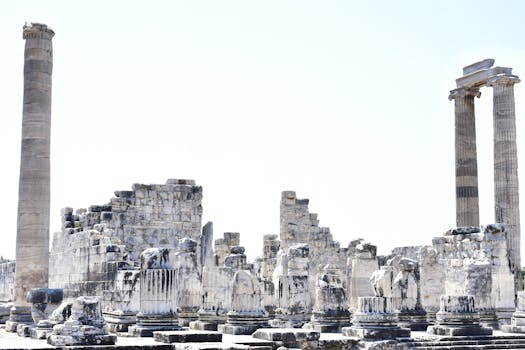Forgotten Civilizations: Archaeological Discoveries and Explorations
For centuries, human civilization has amazed and perplexed us with its incredible achievements in technology, culture, and architecture. However, our understanding of our past is constantly evolving as new archaeological discoveries are made. While ancient civilizations like the Egyptians, Greeks, and Romans are well-known and studied, there are also lesser-known civilizations that were lost to time until recently. These forgotten civilizations not only shed light on our past but also challenge our perceptions of what ancient societies were capable of. In this article, we will delve into some of the most fascinating forgotten civilizations and the archaeological discoveries and explorations that have revealed their secrets.
The Minoans of Crete
The Minoans were a highly advanced and sophisticated civilization that thrived on the Greek island of Crete from around 2700 BCE to 1450 BCE. They were known for their stunning frescoes, colorful pottery, and complex palaces. However, for a long time, the Minoans were overlooked in the study of ancient civilizations until an archaeological discovery in the late 1800s shed light on their existence. Renowned British archaeologist Sir Arthur Evans stumbled upon the remains of the ancient city of Knossos and began excavations. What he uncovered was a civilization that had a writing system, advanced plumbing and drainage systems, and an extensive trade network. The discovery of Knossos revolutionized our understanding of Bronze Age civilizations and put the Minoans back on the map.
The Indus Valley Civilization
The Indus Valley Civilization, also known as the Harappan Civilization, is one of the oldest and most mysterious civilizations in the world. Its existence was unknown to the western world until the early 20th century, when British archaeologists began excavating the ruins of Harappa and Mohenjo-Daro in present-day Pakistan. What they uncovered was a vast urban civilization that thrived from 3300 BCE to 1300 BCE and rivaled the ancient civilizations of Egypt and Mesopotamia. The Indus Valley people had a remarkable level of urban planning, advanced sanitation systems, and a writing system that is yet to be deciphered. Their downfall is still a mystery, making the Indus Valley Civilization one of the most intriguing forgotten civilizations.
The Olmecs of Mesoamerica
The Olmec civilization is considered the earliest Mesoamerican civilization, dating back to 1200 BCE. They are well-known for their colossal stone heads and intricate carvings, but their society was much more advanced than just monumental art. Archaeologists have discovered that the Olmecs had a complex social and political system, with evidence of an elite ruling class and skilled artisans. Their most remarkable achievement, however, was their sophisticated knowledge of astronomy and mathematics, which they used to develop a precise calendar. Although the Olmecs were eventually conquered by other Mesoamerican civilizations, their impact on the region’s culture and religion is still felt today.
The Kingdom of Aksum
Located in present-day Ethiopia, the Kingdom of Aksum was a powerful civilization that flourished from the 1st century BCE to the 7th century CE. It was one of the first civilizations to adopt Christianity as its official religion, and its capital city was a hub of trade and commerce. The Aksumites were renowned for their impressive architecture, evident in the towering obelisks and grand palaces that still stand today. However, the kingdom’s existence was largely forgotten until the 19th century when European explorers and archaeologists uncovered the ruins of its magnificent city and the legendary Queen of Sheba’s palace. The discovery of Aksum has provided valuable insight into the development of early Christianity and the influence of African civilizations on global trade and commerce.
The Khmer Empire of Cambodia
The Khmer Empire, also known as the Angkor Civilization, was a dominant power in Southeast Asia from the 9th to the 15th century CE. Its most famous legacy is the Angkor Wat temple complex, the largest religious monument in the world. However, the Khmer Empire was much more than just a city of temples. Recent excavations have revealed that the Khmer people had a complex and advanced society, with an intricate water management system and skilled engineering. Their downfall is still a mystery, but the ruins of Angkor Wat and the surrounding cities continue to captivate and amaze visitors to this day.
The importance of these forgotten civilizations
The discovery and study of these forgotten civilizations are crucial in our understanding of our past and how we have evolved as a society. They challenge our perceptions of what ancient civilizations were capable of and remind us that the human spirit has always strived for advancement and progress. These civilizations have also left their mark on our modern world, with their influence seen in art, technology, and architecture. As we continue to explore and uncover the mysteries of the past, we must not forget the contributions and legacies of these remarkable forgotten civilizations.
In conclusion, the forgotten civilizations mentioned in this article are just a few of the many ancient societies that have been rediscovered and continue to amaze us with their achievements. From the Minoans in Crete to the Khmer Empire in Cambodia, each of these civilizations has added a new layer to our understanding of human history. As we continue to unearth and explore, who knows what other fascinating civilizations we may discover and what secrets they may hold.











